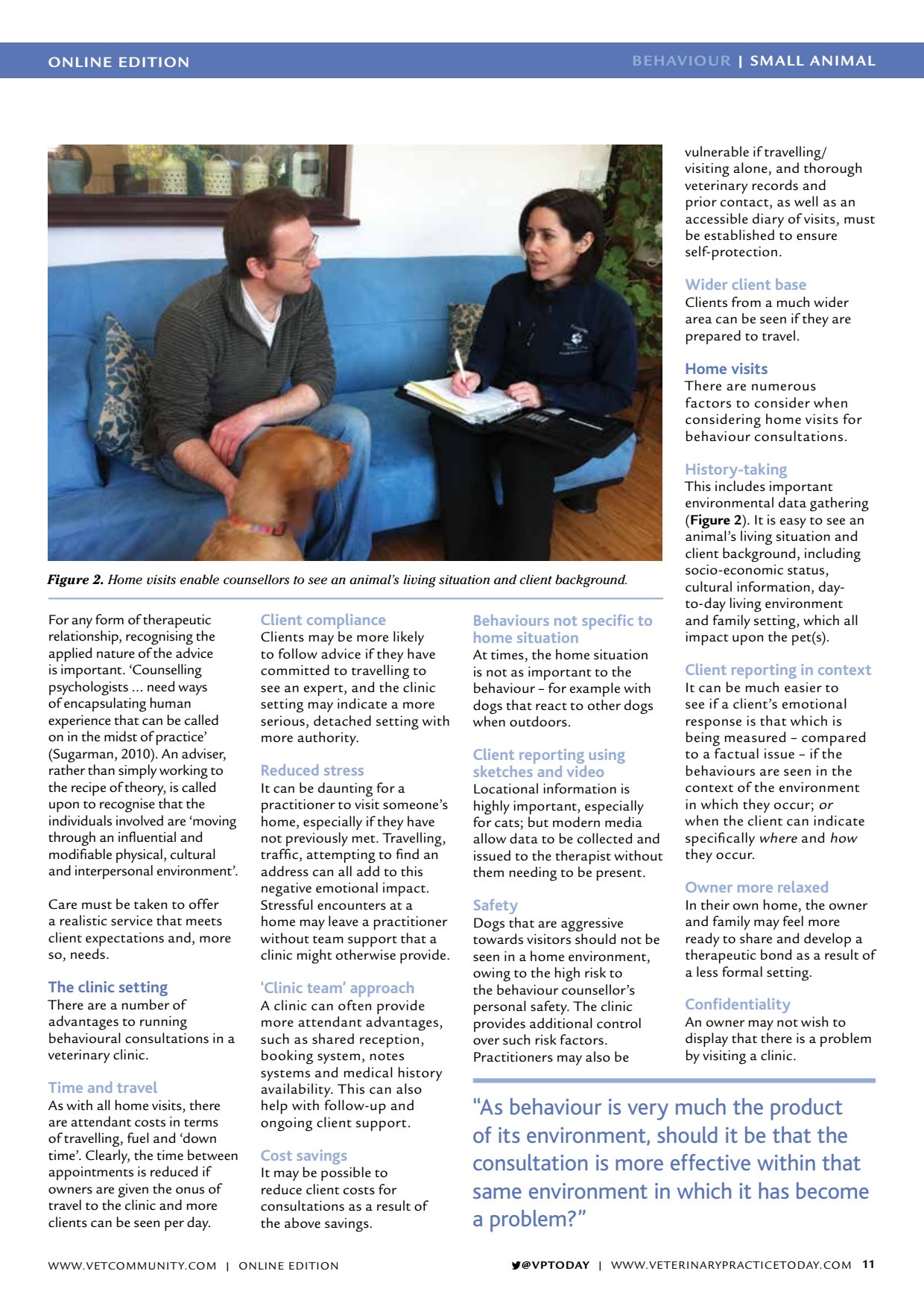clinic setting Time
ONLINE EDITION BEHAVIOUR | SMALL ANIMAL VPTODAY | WWW.VETERINARYPRACTICETODAY.COM 11 For any form of therapeutic relationship, recognising the applied nature of the advice is important. Counselling psychologists need ways of encapsulating human experience that can be called on in the midst of practice (Sugarman, 2010). An adviser, rather than simply working to the recipe of theory, is called upon to recognise that the individuals involved are moving through an influential and modifiable physical, cultural and interpersonal environment. Care must be taken to offer a realistic service that meets client expectations and, more so, needs. The clinic setting There are a number of advantages to running behavioural consultations in a veterinary clinic. Time and travel As with all home visits, there are attendant costs in terms of travelling, fuel and down time. Clearly, the time between appointments is reduced if owners are given the onus of travel to the clinic and more clients can be seen per day. Client compliance Clients may be more likely to follow advice if they have committed to travelling to see an expert, and the clinic setting may indicate a more serious, detached setting with more authority. Reduced stress It can be daunting for a practitioner to visit someones home, especially if they have not previously met. Travelling, traffic, attempting to find an address can all add to this negative emotional impact. Stressful encounters at a home may leave a practitioner without team support that a clinic might otherwise provide. Clinic team approach A clinic can often provide more attendant advantages, such as shared reception, booking system, notes systems and medical history availability. This can also help with follow-up and ongoing client support. Cost savings It may be possible to reduce client costs for consultations as a result of the above savings. Behaviours not specific to home situation At times, the home situation is not as important to the behaviour for example with dogs that react to other dogs when outdoors. Client reporting using sketches and video Locational information is highly important, especially for cats; but modern media allow data to be collected and issued to the therapist without them needing to be present. Safety Dogs that are aggressive towards visitors should not be seen in a home environment, owing to the high risk to the behaviour counsellors personal safety. The clinic provides additional control over such risk factors. Practitioners may also be vulnerable if travelling/ visiting alone, and thorough veterinary records and prior contact, as well as an accessible diary of visits, must be established to ensure self-protection. Wider client base Clients from a much wider area can be seen if they are prepared to travel. Home visits There are numerous factors to consider when considering home visits for behaviour consultations. History-taking This includes important environmental data gathering ( Figure 2 ). It is easy to see an animals living situation and client background, including socio-economic status, cultural information, day- to-day living environment and family setting, which all impact upon the pet(s). Client reporting in context It can be much easier to see if a clients emotional response is that which is being measured compared to a factual issue if the behaviours are seen in the context of the environment in which they occur; or when the client can indicate specifically where and how they occur. Owner more relaxed In their own home, the owner and family may feel more ready to share and develop a therapeutic bond as a result of a less formal setting. Confidentiality An owner may not wish to display that there is a problem by visiting a clinic. Figure 2. Home visits enable counsellors to see an animals living situation and client background. As behaviour is very much the product of its environment, should it be that the consultation is more effective within that same environment in which it has become a problem? WWW.VETCOMMUNIT Y.COM | ONLINE EDITION
